I take sports history seriously. If a guy or a team or a league deserves to be blasted, I do not hesitate to pile on the TNT and hit the detonator button. But when somebody merits recognition and praise, I am willing to give it in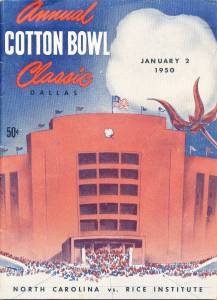 abundance. Tobin Rote (January 18, 1928−June 27, 2000) falls into the second category.
abundance. Tobin Rote (January 18, 1928−June 27, 2000) falls into the second category.
A native of San Antonio, he graduated from Harlandale High School and accepted Rice football coach Jess Neely’s offer of a scholarship. And how did the Owls do during his four years in Houston? They won or shared two Southwest Conference championships and prevailed in the 1947 Orange Bowl (an 8-0 defeat of Tennessee) and the 1950 Cotton Bowl (27-13 over North Carolina). I find it hard to believe that Rote, who threw two touchdown passes in that game against the Tar Heels, did not make all-SWC as a senior.
Nevertheless, the Green Bay Packers saw something in the jut-jawed, 6′ 2″, 215-pound Texan. They took him in the second round of the 1951 draft, and he immediately became the main QB. Green Bay’s coach, Gene Ronzani, installed an early version of the shotgun to take advantage of Rote’s skills. A one-man gang for the Pack, he led them in rushing four seasons and did all he could to make a bad team 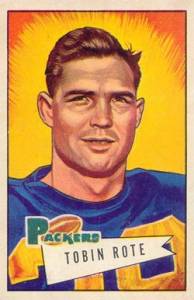 respectable. In 1956, Rote led the NFL in passing yards (2,203), set a league record of 18 TD passes and scored 11 times on the ground. Responsible for 29 touchdowns, he saw his teammates score just five.
respectable. In 1956, Rote led the NFL in passing yards (2,203), set a league record of 18 TD passes and scored 11 times on the ground. Responsible for 29 touchdowns, he saw his teammates score just five.
I suspect Rote was pleased to be traded to Detroit in the summer of 1957. The culture there was very different—championships in 1952 and 1953, and a spot in the title game in 1954. Coach Buddy Parker expected him to be second-string to Bobby Layne, but when Layne broke an ankle in the 11th game, the rangy Texan was ready. Rote did not just step in, he stepped up. The Lions met San Francisco for the Western Division title and fell behind 27-7 at halftime. Not to worry, as our man Tobin led the silver and blue to a 31-27 comeback victory. The next week, they thumped the defending champion Cleveland Browns, 59-14. Rote completed 12 of 19 passes with four touchdowns and ran one over himself.
He stayed in Detroit another two seasons (Layne had been traded to Pittsburgh), but the team went kaput almost immediately. A 10-year vet, Rote was waived. For whatever reason, he did not sign with one of the franchises of the fledgling American Football League—the Houston Oilers or the Dallas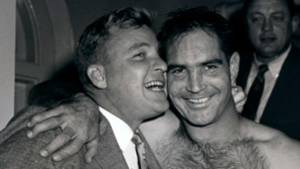 Texans, for example. He chose instead to go north and play for the Toronto Argonauts of the CFL. In three seasons, he completed 662 of 1,187 passes and threw for 62 touchdowns. While the Argos did not win a Grey Cup, they came close twice.
Texans, for example. He chose instead to go north and play for the Toronto Argonauts of the CFL. In three seasons, he completed 662 of 1,187 passes and threw for 62 touchdowns. While the Argos did not win a Grey Cup, they came close twice.
He was not finished. The AFL finally came calling in the form of Sid Gillman of the San Diego Chargers. Rote led them to an 11-3 record and a 51-10 defeat of the Boston Patriots in the title game at Balboa Stadium. The AFL’s player of the year, Rote appeared on the cover of Sports Illustrated with teammate Paul Lowe. The ’63 Chargers were playing with a loaded deck. At the beginning of training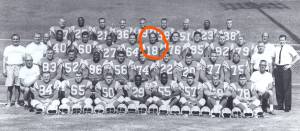 camp, Gillman told his men they would be consuming five milligrams of anabolic steroids every day. In conjunction with weight-lifting, this would, he averred, make them stronger, give them added endurance, enable them to run faster and facilitate quicker recovery from injuries. They soon realized their coach was right. At the time, I should point out, steroids were entirely legal. But never before had they been used in such a comprehensive way.
camp, Gillman told his men they would be consuming five milligrams of anabolic steroids every day. In conjunction with weight-lifting, this would, he averred, make them stronger, give them added endurance, enable them to run faster and facilitate quicker recovery from injuries. They soon realized their coach was right. At the time, I should point out, steroids were entirely legal. But never before had they been used in such a comprehensive way.
John Hadl, then the team’s heir apparent at quarterback, handled most of the snaps in 1964, but as the playoffs approached Gillman turned back to Rote. The Chargers again reached the AFL title game but lost to the Buffalo Bills. Rote had been honored by the hometown folks on December 13, 1964 at halftime of a 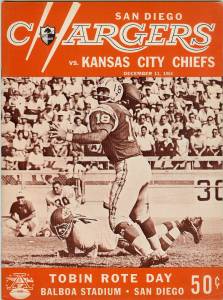 game against Kansas City (unfortunately, a 49-6 Chiefs victory). Gifts were given and speeches made, and he and his wife Betsy circled the field in a convertible.
game against Kansas City (unfortunately, a 49-6 Chiefs victory). Gifts were given and speeches made, and he and his wife Betsy circled the field in a convertible.
Weary after 15 years of pro ball, Rote retired and then foolishly came back in 1966 with the Denver Broncos. His mobility all but gone, he made brief appearances in three games for the woeful Broncs and was waived. Rote worked as a corporate executive in Detroit after retirement and had a home in Saginaw. That’s where he died of a heart attack at age 72.
Why is he less well known than his cousin Kyle Rote? (Born just 10 months apart in San Antone, they had the same paternal grandparents. Rote starred as a running back/receiver at SMU and then with the New York Giants. Both were, no doubt, excellent college and pro players.) Tobin Rote’s success at Rice in the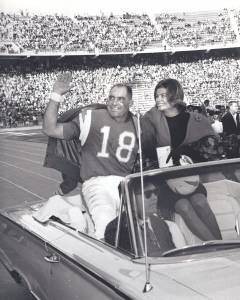 late 1940s convinced the university and the city of Houston to join forces to build 70,000-seat Rice Stadium in 1950. Blessed with a big-time arm and rare speed, Rote is the only man to have played quarterback on championship teams in the NFL and AFL, and his work with the Packers and Argos was admirable as well. The three years in Canada aside, he had 148 touchdown passes and 3,128 yards rushing. At the time he quit, no other quarterback had run for so many yards, and only Michael Vick, Randall Cunningham, Russell Wilson and Cam Newton have topped his 4.9 yards per carry. If Vince Lombardi had been brought to Green Bay a few years earlier, I submit that a bust of Tobin Rote—the first real dual-threat quarterback—would be on display at the Pro Football Hall of Fame.
late 1940s convinced the university and the city of Houston to join forces to build 70,000-seat Rice Stadium in 1950. Blessed with a big-time arm and rare speed, Rote is the only man to have played quarterback on championship teams in the NFL and AFL, and his work with the Packers and Argos was admirable as well. The three years in Canada aside, he had 148 touchdown passes and 3,128 yards rushing. At the time he quit, no other quarterback had run for so many yards, and only Michael Vick, Randall Cunningham, Russell Wilson and Cam Newton have topped his 4.9 yards per carry. If Vince Lombardi had been brought to Green Bay a few years earlier, I submit that a bust of Tobin Rote—the first real dual-threat quarterback—would be on display at the Pro Football Hall of Fame.

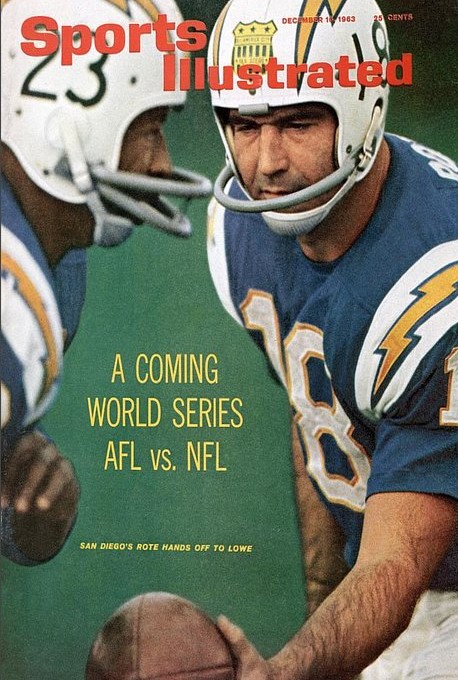
8 Comments
I agree with your sesame time of Rote. I’ve known about about Kyle since I got married to my wife, since she was a SMU graduate and we had best a good friend who was the niece of Kyle, and I never heard her speak of Tobin. The Rote genes were evident in the children of the niece, all four were gifted in their respective pursuits of dance and sports.
Gary–thanks for your comment, as always. My impression is that Kyle Rote was a higher status college player (along with the great Doak), runner-up for the 1950 Heisman Trophy. And yet look what his cousin did in Houston! In the pros, we really get our answer. Kyle was in New York, while Tobin had the misfortune to be stuck in Green Bay…at that time, it was truly the Siberia of the NFL. Still, he did not complain. He forged a heck of a career with four pro football teams (not including that brief stint with the Broncos). There is at least one guy who campaigns for Tobin Rote in the Pro Football HOF. I borrowed some of his points here.
Enjoyed this article. I remembered Tobin Rote from his time with the Chargers. They had a very prolific offense with wide receiver Lance Alworth (Bambi), running backs Keith Lincoln and Paul Lowe, and Rote. Sid Gillman was very innovative and took advantage of the skill sets of his offensive stars. Thanks for the memories.
Thanks, Kent. Yes–Lincoln, Lowe, Bambi and others…Speedy Duncan and Ernie Ladd on defense too. One thing I would add about Rote is that he was the two-time SWC champ in throwing the javelin!
Richard:
Wonderful article with some great details and research. A great touch was the SI cover photo and the program cover of Tobin Rote day. I remember his play as a Detroit quarterback and that incredible comeback from a 27-7 deficit. He really was talented but Kyle played in NYC and Tobin in Green Bay. As you know, the world was different in 1950.
Thanks for A great article!
Rex
Rex–you make a valid point about Tobin and Kyle (Green Bay and NYC). His legacy might be quite different if he had been drafted by the Giants or Bears or some other prominent team. Still, what a career!
Richard-Great article. Like most people, I guess, I remember Kyle Rote well, but Tobin just barely. Being a soccer fan, I remember Kyle Rote, Jr., pretty well, too. So I really enjoyed reading about Tobin. Quite a ball player. The Rotes really had the athletic gene.
One of the San Antonio Rote boys died in WW2 in 1945…. I did not mention Junior, but you are right–quite an athlete. Football, hoops and soccer at Highland Park HS, Dallas Tornado and much more
Add Comment